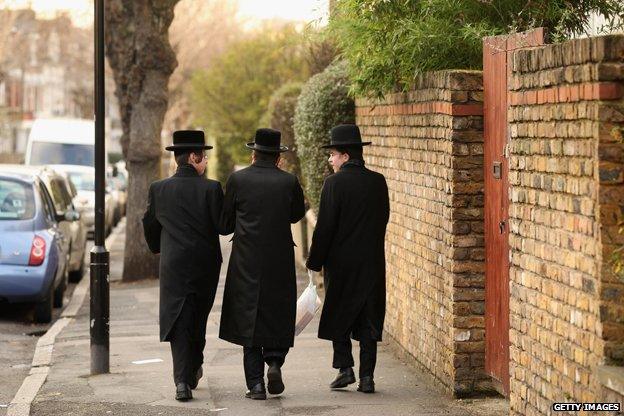Is there a ‘rising tide’ of anti-Semitism in the West?
- Published

Following the recent conflict between Israel and Palestinians in Gaza, there have been reports from a number of countries of attacks targeting Jews. But does the evidence support claims that anti-Semitism is on the rise?
In France and Germany, synagogues and Jewish community centres have been firebombed. In Britain, a rabbi was attacked near a Jewish boarding school. And in Australia, a bus carrying Jewish schoolchildren was targeted by teenagers shouting "Heil Hitler" and threatening to slit the children's throats.
As a result, newspapers have reported a "rising tide of anti-Semitism in Britain, external", that Europe is facing the "worst times since the Nazis, external'' and that we're witnessing a "dramatic rise in global anti-Semitism, external".
But while anti-Semitism is clearly a problem, is it correct to say that it is increasing?
In Britain, the Jewish organisation the Community Security Trust (CST) monitors anti-Semitic incidents. These include violent attacks on people or property, threats, anti-Semitic graffiti and online expressions of anti-Semitism.
The CST says it received around 240 reports of anti-Semitic incidents in July, which it describes as five times the monthly average. The UK Association of Chief Police Officers, which has released statistics on hate crime since 2009, has talked of a "significant rise" in anti-Semitism since the latest fighting began in Gaza in early July.

Looking at previous conflicts, such as the Israeli offensive in Gaza in 2008-2009, anti-Semitic incidents do seem to rise in their wake, before falling again. But it could be that some of that rise is because in times of conflict people are also more aware of anti-Semitism, and more likely to report incidents which previously would have gone unreported.
The CST also reported 304 anti-Semitic incidents in the first six months of this year, an increase of 36% compared with the same period of 2013.
Over the longer term, 2013 saw the lowest annual number of anti-Semitic incidents in Britain since 2005. During the past decade the levels have fluctuated making it difficult to identify a long term trend - although the number of incidents has declined steadily from a peak in 2009 to the end of 2013, it is higher than it was 10 years ago.
What about Europe? The European Union Fundamental Rights Agency (FRA) publishes a report every year summarising data on anti-Semitic incidents supplied by governments and NGOs. The problem is that only around half the EU states collect this data, and the quality varies hugely.
"It is very incomplete - it's really difficult to tell trends over time at present," says FRA spokesperson Katya Andrusz
In the countries with better data, the picture is mixed. In Germany anti-Semitic acts declined in the decade to 2011, before rising slightly in 2012. In Sweden the trend has been upwards, although the overall number of incidents is low.
In France, concerns about anti-Semitism have been raised by a number of high profile incidents including the killing of a teacher and three children at a Jewish school in Toulouse in 2012. There, the official data also shows the number of incidents has fluctuated up and down, trending downward in the decade to 2012 before rising that year.

Recent incidents of anti-Semitism

In May 2014, a man shot and killed four people in the Jewish museum in Brussels, Belgium
Following the start of the recent Gaza conflict, a protest took place in Sarcelles, Paris in July (above), resulting in violence when Jewish-owned businesses and a synagogue were targeted and anti-Semitic phrases were shouted
Anti-Semitic phrases chanted at Gaza protests in Berlin, external and an Israeli tourist attacked there in July
The Jewish Society in Denmark says it has had reports of 29 physical, verbal and online attacks on Jews, external since the start of July

Elsewhere, in the US, which is home to almost 70% of the world's Jews who live outside Israel, statistics from the FBI and Jewish organisation the Anti-Defamation League (ADL) both show a steady long-term decline in anti-Semitic incidents - according to the ADL they were down 19% in 2013 compared to the previous year.
In Australia, Jeremy Jones of the Australia/Israel and Jewish Affairs Council has been collecting data on anti-Semitic incidents since 1989. Although his numbers suggest a rise in 2013, it's difficult to see a clear trend over the past decade.
"The major development I have identified in recent years has been the growth in reports of incidents of harassment of identifiably Jewish people in public streets," he says.
"Violent incidents, which have understandably featured in media coverage, are still relatively rare and there is not yet data to suggest any changes."
One thing that is apparent looking at the data from France, the UK and Australia, is that although the numbers have fluctuated over the past decade, the average level is higher than it was in the 1990s.
"Since 2000, the beginning of the Second Intifada, we've had a very clear explosion of actions and threats against people identified as Jews," says Prof Nonna Mayer from Sciences Po University in Paris, referring to the Palestinian revolt against Israeli occupation of Gaza and the West Bank.
Another way to assess whether anti-Semitism is on the rise is to look at attitudes - how people think and feel about Jewish people.
Several commentators have referred to a poll from earlier this year by the US Jewish organisation the ADL. The poll surveyed people in 101 countries, and suggests that a quarter of the world's population harbour anti-Semitic attitudes.
But critics have a number of concerns with the way the survey was constructed. The ADL presented 11 statements about Jewish people, ranging from "Jews are responsible for most of the world's wars" to "Jews have too much control over the United States government". People who answered "probably true" to six or more of the statements were classified as anti-Semitic by the ADL.
"That's a very sharp distinction," says Prof Ryan Enos from Harvard University, who studies how different groups of people relate to one another. "From what we understand about human attitudes, they don't tend to work that way." He says that anti-Semitism is better understood as a spectrum of attitudes.
Enos also has concerns about the questions themselves.
"They don't necessarily reflect the type of way we would try to measure attitudes in social science surveys now because people could have different interpretations of what the responses to these questions mean," he says.
That's one of the biggest issues of all when trying to measure attitudes - there are some things that are clearly anti-Semitic, but there are also a number of areas and issues, such as criticism of Israeli government policy, where there's debate.
More reliable data on attitudes in Europe comes from long term academic studies of public opinion. Nonna Mayer runs one such study which is used for the official annual report on human rights and hate crime in France.

"We have many surveys, even before 1990. What they show is a decline in prejudice towards minorities, and especially towards Jews. Actually Jews are the best accepted minority in France," she says.
"But what we also see in the context of economic recession since 2009, prejudice which was decreasing since World War Two has been going up again, also for the Jews. But the Jews remain the most accepted group in France. We see the same thing in Europe."
This is reflected in the Pew Foundation 2014 Global Attitudes survey - which suggests that in Europe unfavourable attitudes towards Roma and Muslims are more prevalent than those toward Jews.
The Pew survey also reports lower levels of anti-Semitic sentiment than suggested by the ADL survey. For France, the Pew survey suggests 10% of people have unfavourable attitudes towards Jewish people, which contrasts with the ADL poll's suggestion that 37% of people in France are anti-Semitic.
While it's difficult to see clear evidence of a broad upward trend in anti-Semitism, there's still fear in some parts of the Jewish community.
A poll published last week by the Jewish Chronicle website suggested that "almost two-thirds of British Jews have questioned their future in the UK, external amid rising anti-Semitism".
The Jewish Chronicle told the BBC that the poll was conducted by asking 150 Jewish people at random on the streets of North London whether they or their friends "had a discussion about whether there is a future for Jews in the UK".

This is not a representative sample, meaning the results should be read with caution. But it's easy to see how such reports can add to a feeling of fear.
A more detailed survey of opinions amongst Jewish people was published in 2013 by the EU's FRA. It surveyed Jewish people's experiences and perceptions of anti-Semitism in eight European countries.
The survey suggests that two thirds of people questioned consider anti-Semitism to be a problem, and three quarters say that anti-Semitism has worsened over the past five years in the country where they live.
Again the findings may not be completely representative, because the survey respondents were found through Jewish community organisations, rather than randomly.
"Among Jews in Europe today there's real fright, there's real anxiety," says Mayer, "But I wouldn't put the opinions and the acts at the same level. [In France] how many acts of violence? 100 in 2013. So a minority is enough to frighten, to say maybe it's going to happen to me or my children."
So while the overall trends are harder to discern, the current nature and level of anti-Semitic incidents are enough to make some Jewish people feel afraid.

More from the Magazine

Hugh Schofield charts the development of satirist Dieudonne M'bala M'bala, who inspired the controversial quenelle gesture. He has been condemned on several occasions for anti-Semitic remarks, but denies he is anti-Semitic, saying his attacks on Israel are another matter and that anti-Zionism is a defensible political position.

Listen to More or Less on BBC Radio 4 and the World Service, or download the free podcast
Subscribe to the BBC News Magazine's email newsletter to get articles sent to your inbox.